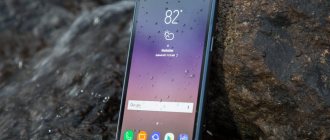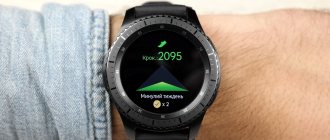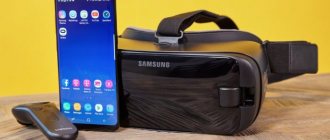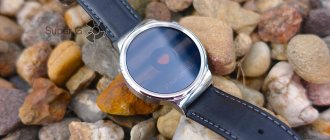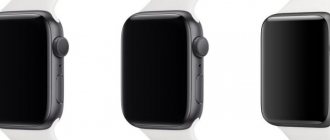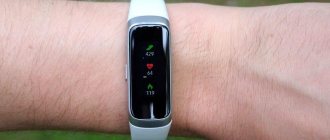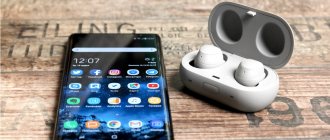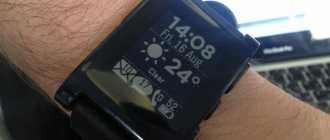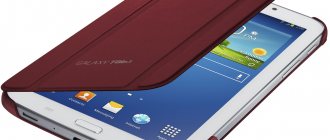The Samsung Galaxy Gear smartwatch allows you to quickly view the time, date, notifications received on your phone, and control the playback of songs in your music player. With their help, you can quietly take a photo and share it immediately on social networks. The design of the device is discreet, the screen is sufficient to make out the text without looking closely for a long time. A detailed review of the Samsung Galaxy Gear follows.
Brief overview of technical characteristics
There are 2 versions of Samsung Gear smartwatches: Classic and Sport. Next we will talk about the first option.
Specifications:
- 1-core processor, clock frequency 800 MHz;
- display: touchscreen, 1.63 inches, Super AMOLED, 320×320 pixels, 277 ppi;
- RAM: 512 MB;
- built-in memory: 4 GB;
- 2 microphones, 1 speaker;
- communication: Bluetooth 4.0;
- sensors: accelerometer, gyroscope;
- camera: 1.9 MP;
- battery: lithium-ion, 315 mAh;
- dimensions: 56.5×36.8×11.1 mm;
- weight: 73 g.
The company keeps secret what kind of processor it uses for the watch; it is clear that its power is low. Such a device does not require anything better, because it opens videos, supports games and the use of high-load programs.
The watch cannot work independently, there is no SIM card slot, so connecting to a smartphone is necessary. Moreover, synchronization is only possible with certain models of Samsung phones.
Galaxy Gear S specifications:
- two-inch touch screen with a resolution of 480x360 pixels;
- dual-core processor with a frequency of 1 GHz;
- 512 MB RAM, 4 GB internal memory;
- Wi-Fi support, Bluetooth 4.1 LE, 2G/3G;
- Li-Pol 300 mAh battery, providing up to two days of battery life for the device.
The size of the watch itself is quite large - 39.8x58.3 mm
, but thanks to the reduced thickness and curved shape compared to previous models,
the watch does not look bulky even on a woman’s hand
.
When purchasing, you need to take into account that the watch strap is part of the design
and it will not be possible to replace it with another. At the moment, the strap is available in two colors – white and black. The button that allows you to control the watch has been moved from the side surface to the front surface and is located directly under the screen.
Packaging and equipment
The Samsung Galaxy Gear gadget was designed specifically for the Note line of smartphones, which is why the packaging is appropriate. This is a cubic box made to look like light wood.
Inside the box are the watch itself, a charger that includes a cradle and a cable with a Micro-USB connector, and brochures with useful information on management. The gadget holder is gray with a ribbed finish that imitates leather.
Screen Features
The device is controlled by a Super AMOLED touch screen.
Some gestures are supported:
- waving your hand from top to bottom in the first menu will open the camera;
- with a wave of your hand from top to bottom in the second menu, open the main menu of the watch;
- There is a scrolling of photos with gestures to the right and left.
The display diagonal is 1.63 inches with an extension of 320x320 pixels. The picture is bright and saturated, brightness is adjustable, excellent viewing angle. The only thing is that Samsung Gear smart watches do not behave well in the sun: the colors fade, although the text remains readable. To save battery, the backlight is set to 7 seconds, but this parameter can be changed in the settings. The screen lights up when you move your hand, and thanks to the built-in accelerometer, the watch detects the rise and rotation of your wrist.
The touch response speed is good, sometimes it happens that the sensor does not work, but such cases occur infrequently.
Samsung Galaxy Gear Fit smartwatch: another matter
At one time, in a review of the Sony SmartWatch 2 and the first generation Samsung Galaxy Gear smartwatches, we noted that both devices have such a combination of advantages and disadvantages that some kind of “arithmetic average” would be ideal. That is, a smartwatch that combines the most important advantages of both of these models. In short, the Samsung Galaxy Gear Fit is the “best of both worlds.”
It would be useful to start a more detailed story with an analysis of the used iron. The “large” Galaxy Gear, both the first and second generations, uses a full-fledged operating system: in the first generation it was Android, in the second it was Tizen, a joint development of Samsung and Intel. A serious operating system requires a serious processor: in the Galaxy Gear it was a rather bulky Samsung Exynos 4212 chip, albeit with a reduced frequency and a disabled second core. In turn, a serious chip means a serious consumption of energy, which is especially critical in the case of an extremely compact device, in the case of which it is simply physically impossible to fit a capacious battery.
In turn, Sony SmartWatch 2 operated under simple software, which could not even be called an operating system. The advantage is that such software is quite sufficient for a much more prosaic processor: Sony used a chip based on the ARM Cortex-M3 architecture and operating at a frequency of 200 MHz.
The same is true for the Samsung Galaxy Gear Fit. There is no full-fledged operating system, so you can get by with a slow and economical processor. In this case, this is one of the chips produced by ST Microelectronics, based on the Cortex-M4 architecture. Compared to the M3, it has a couple of advantages: a built-in DSP and an FPU unit, but this, in general, does not change the essence: it is about the same simple, low-power and not at all power-hungry chip.
Among other things, Gear Fit has a “find my device” feature.
Additionally, the Galaxy Gear Fit uses a noticeably smaller display than the Gear and Gear 2 (it's still AMOLED, of course). Despite the larger diagonal value - 1.84 versus 1.63 inches - its area due to its highly elongated shape is much smaller: 5.95 instead of 8.57 cm2. The total number of points has been reduced by almost half: 55 thousand versus 102. Accordingly, the display, all other things being equal, also consumes less.
The device does not have a camera, microphone or speaker, or even any significant amount of flash memory: all this also saves precious cubic millimeters inside the case and milliwatts of power consumption.
A miniature docking station is used for charging. You will have to use it much less often than with a regular Galaxy Gear
The result is as simple as it is pleasant: if a regular Galaxy Gear has to be charged at least once every two days, and with active use, sometimes every day, then the Gear Fit can last at least two days without charging. On average - three. The maximum optimistic value of 5 days declared by Samsung is also not fantasy: with minimal use of the display, the Gear Fit can actually live that long. And this is all despite the fact that the battery capacity of the Gear Fit, due to the miniature size of the device, is significantly less than that of a full-fledged Gear.
| Characteristics | Samsung Galaxy Gear (SM-V700) | Samsung Galaxy Gear Fit (SM-R350) |
| Display | 1.63 inches, 320×320 AMOLED Anti-glare filter, oleophobic coating Capacitive touch screen | 1.84 inches, 432×128 AMOLED Anti-glare filter, oleophobic coating Capacitive touch screen |
| CPU | Exynos 4212: one core ARM Cortex-A9 (ARMv7) frequency 800 MHz; process technology 32 nm HKMG | ST Microelectronics STM32F439ZI: single core ARM Cortex-M4 (ARMv7-M) frequency 180 MHz |
| Memory | 512 MB + 4 GB flash | 256 KB SRAM, 2 MB Flash (integrated into processor) 16 MB additional flash memory |
| Charger | Via micro-USB docking station | |
| Bluetooth | 4.0LE | |
| NFC | In the docking station | No |
| Sensors | Accelerometer/gyroscope | Accelerometer/gyroscope, heart rate sensor |
| Microphone and speaker | Eat | No |
| Camera | 2 MP (1392×1392), BSI sensor, autofocus Recording short videos | No |
| Battery | 1.2 Wh (315 mAh, 3.8 V) | 0.8 Wh (210 mAh, 3.8 V) |
| Weight | 74 g | 27 g |
| Water and dust protection | No | IP67 |
| Compatibility | Any Samsung smartphones that have received an update to Android 4.3 | |
| Approximate prices | 11,990 rubles | 6,990 rubles |
With all this, the Galaxy Gear Fit retains the most important advantage of the original Gear: convenient interfaces both in the watch itself and in the application through which the watch interacts with the smartphone. Another major advantage of the Gear Fit is its downright space-age design. The Koreans have finally figured out where to use curved AMOLED displays. In this case, the bend is really appropriate, and all this digital luxury looks like a real hello from the future.
It’s especially nice that the simple hardware made it possible to make the watch not too expensive. So this is a future that you can not only touch in a store, but also have for your permanent use without serious remorse about wasting the family budget.
Since the strap does not have any functional elements, it was made removable. In addition to classic black, five more colors are available: brown, blue, green, red and orange. Additional straps will have to be purchased separately.
Galaxy Gear Fit and Galaxy S5 heart rate sensors
The gadget is as light as possible - it weighs almost nothing. And this, in general, is understandable: after all, the Galaxy Gear Fit is not so much a smart watch as a fitness bracelet. Since just games with an accelerometer were not enough for the Koreans, they also built a heart rate monitor into the Gear Fit. It does not work quite correctly, however: for example, after climbing a fairly high and steep hill, the sensor persistently showed values in the region of 50-60 beats per minute.
The heart rate sensor of the Galaxy S5 is equipped with a red diode, but for some reason the Galaxy Gear Fit has a green diode
The S Health application is used to track sports achievements. The application remembers a bunch of all kinds of information about your movements, including local coordinates - however, for the latter you will have to have a smartphone with you, because there is no GPS receiver in the watch itself.
Despite the fact that the Galaxy Gear Fit is focused more on fitness, as a smart watch - that is, a visual headset for a smartphone - this device also works quite successfully. Due to the elongated display, viewing notifications is not as convenient as on the square display of the regular Gear. But the inconvenience is not critical: you get used to the non-standard display quite quickly.
According to the latest mobile fashion, the new Samsung smartwatches have acquired serious protection against moisture and dust. Of course, the sportiest of the new models is no exception: the Gear Fit watch is completely dustproof and can be submerged to a depth of up to a meter. Even if you don't intend to swim in them, this is useful at least in the sense that the Gear Fit can be washed with soap at any time.
Samsung Galaxy Gear Fit is IP67 dust and water resistant
Overall, the device is very interesting, with an excellent design, quite user-friendly software, fairly decent battery life and a very reasonable price. By and large, there is only one drawback: Galaxy Gear Fit can only with Samsung devices, and even then not all: the list of compatible gadgets currently includes 17 smartphones and tablets of the Galaxy family. Closed club.
Camera and its capabilities
The 1.9 Megapixel Samsung camera has image autofocus. It can’t compete with a photo taken from a phone, but you will get some high-quality shots. Similar ones are used on the front cameras of smartphones and are intended primarily for video communication. The photo module allows you to shoot videos up to 15 seconds long, and the photo extension is 1280×960 or 1392×1392 pixels.
The camera has some difficulties with accentuating details, white balance, and it will be difficult to photograph something worthwhile on a cloudy day - you don’t even have to try. In sunny conditions, an acceptable photo comes out, and most importantly, very quickly. The watch is always on your hand, you don’t need to take it out of your pocket, so the photo is ready in just a couple of seconds.
The camera is on the bracelet, which makes the process both easier and more difficult. Sometimes you just have to twist your hand to “catch” the object of interest. It is much easier to take a “spy” photo with a watch than with a smartphone, but it is not a fact that the user will go unnoticed.
There is one more problem - pictures are saved in the device’s memory, and if it is full, they are automatically deleted. What saves the situation is the ability to transfer photos via Bluetooth to a smartphone: manually or automatically.
Samsung Gear S3 Classic review: a new smartwatch classic
We recently published our first look at Samsung's new product - the Gear S3 smart watch. Now a detailed review of the new smartwatch has been released on 4pda.
It seems that smart watches are a very recent invention that has yet to prove its viability. But this year, Samsung released no less than the fifth generation of its smart watches - the Galaxy Gear S3 Classic. The South Korean manufacturer did not return to using a curved display, but noticeably “pumped up” the gadget, which received a new “stuffing” and, most importantly, a rotating bezel for controlling the device. How convenient the innovation turned out to be, and what other surprises the Gear S3 has in store – we’ll tell you in the review.
Specifications Samsung Gear S3 Classic
- Screen: Super AMOLED, 1.3″, 360×360, 278 ppi
- Processor: dual-core Samsung Exynos 7270, 1 GHz
- Graphics accelerator: ARM Mali-T720
- Operating system: Tizen 2.3.2
- RAM: 768 MB
- Built-in memory: 4 GB
- Memory card support: no
- Wireless interfaces: Wi-Fi 802.11b/g/n, Bluetooth 4.2, NFC, MST
- Navigation: GPS, GLONASS
- No camera
- Sensors: accelerometer, microgyroscope, barometer, heart rate monitor
- Battery: 380 mAh, Li-Ion, non-removable
- Dimensions: 49x46x12.9 mm
- Weight: 59 grams
Packaging and equipment
The smart watch comes in a cylindrical box, the design of which is made in blue and black. Inside, the gadget itself is fixed in a vertical position, and in the compartment under it there is a wireless charger, an additional, shorter strap and a power supply with a micro-USB connector.
Appearance
Samsung offers smartwatches in two versions: Frontier and Classic. The first is distinguished by support for eSIM cards and cellular communications, but the classic version has been tested, which is named so for good reason: from a distance, the Gear S3 is indistinguishable from a regular mechanical watch (or electronic, depending on what dial you have installed). There are no color modifications; if you buy the Classic model, you will receive a mirror-silver stainless steel case and two black leather straps of different sizes. However, you can buy absolutely any strap - a standard 22 mm mount is installed on the gadget’s body. The gadget is sealed and certified to the IP68 standard, which allows the device to continue operating at a depth of more than 1.5 meters for longer than 30 minutes. Despite this, you should not swim while wearing a watch, especially in salt water.
The front panel of the watch is occupied by the display, which is located in a small recess - this should protect it from getting scratched too quickly. The outer contour of the bezel protruding above the display is covered with notches for more convenient rotation.
On the right side of the watch there is a microphone, a back button and a home button, which, despite the specific name, is multifunctional. The buttons are quite large and have a clear tactile response. An unpleasant feature noticed by the author is that when wearing the watch on the right hand, the buttons can be accidentally pressed by the sleeve of the jacket. This cannot be called a disadvantage, but left-handers should keep this nuance in mind.
There are no buttons on the left, but there is a perforation behind which the speaker is hidden. The reverse side of the watch case is made of plastic; a heart rate monitor is located in the middle of the rear panel.
Ergonomics
The Gear S3 Classic is no larger or heavier than almost any mechanical watch of the same diameter. However, we advise you to try on the gadget before purchasing, especially for girls.
The feeling of a watch on your hand will be purely individual - for some, like the author, the gadget will instantly become an extension of your hand, while for others it will seem too big.
Screen
The watch is equipped with a fully round display with a Super AMOLED matrix with a diameter of 1.3″ and a resolution of 360x360 pixels, which gives a density of 278 ppi. In terms of characteristics, the display is practically not inferior to the screens of Samsung flagships - it has excellent color rendition and picture clarity. Pixelation when using the watch is not noticeable, and the maximum brightness of the display is even excessive when using the device and will only be necessary on the sunny days. The screen is protected by Corning Gorilla Glass SR+, which is coated with a high-quality oleophobic coating. The watch supports adaptive brightness control, but it was not possible to find out exactly where the manufacturer placed the light sensor. At least the presence of the sensor did not prevent the manufacturer from making a completely round display.
Like Samsung smartphone screens, the Gear S3's display has a high-sensitivity mode that allows you to operate the device even with gloves. The display can simultaneously recognize up to two touches, although multi-touch gestures in the Gear S3 are rarely used and only in third-party applications.
Interface
Gear S3 runs on Samsung's own operating system, Tizen 2.3.2, which allowed the manufacturer to implement an unusual interface and functions that are not found in Android Wear. The fastest and most convenient way to control the new interface is the bezel. It is used to scroll screens and lists, switch tracks in the player, change brightness, volume, and has a number of other functions that depend on the running application. Thanks to this method of controlling the watch, interaction with the gadget has been made extremely simple: in most standard programs, the required action is selected by rotating the bezel, and confirmation is carried out by pressing the center of the screen. Of course, the clock also supports a more familiar control method - scrolling by swiping and selecting the desired icon by tapping, but this is not so convenient.
In smart watches, by analogy with desktops on a smartphone, the concept of widgets was implemented. The first widget on the home screen is the watch face. It cannot be removed, but, of course, it can be changed. Additionally, most standard watch faces are customizable in some way. Typically, the user has access to a choice of colors and display of additional information.
The rest of the widgets, which are located clockwise from the dial, can be customized by the user: add, delete, and change the order.
Most widgets are added to the main menu only once, but some (such as widgets with app shortcuts and favorite contacts) are allowed to be duplicated.
Counterclockwise from the dial are cards with notifications - they can come from applications on the watch itself, or duplicated from a smartphone. The text of smartphone notifications is always displayed on the watch, but reactions for it are not available for all applications. For example, clicking the “Reply” button on a Hangouts notification will only open that messenger on your phone. To remove any notification, simply swipe it up.
Pressing the bottom button while the watch face is open launches the application menu. The program is selected using the bezel, and to launch it, just tap on the center of the screen. If you hold your finger down, the menu will go into edit mode, from which you can remove third-party applications and change their order, including moving shortcuts between pages.
In addition to controlling the bezel and taps, the smartwatch also supports S Voice - voice input of commands. To launch it, just double-click the bottom button, or say the phrase “Hello, Gear.” Smart watches can use voice commands to launch programs, set a timer and alarm, show the weather and perform a number of other functions.
Swiping down from the top of the watch face opens the quick settings panel, where you can adjust the brightness, volume, enable Airplane or Do Not Disturb modes, and launch the audio player.
On those rare occasions when you need to enter text, you can use either S Voice or the keyboard. Switching between layouts, number pad and emoticon panel is done using the bezel.
In the dialer, the keyboard is designed differently and is located in a ring. You can use your watch to receive incoming calls from your smartphone, and then talk using the built-in microphone and speaker of the watch, or a headset.
Synchronization with smartphone
To control your watch from your smartphone from Google Play, you must install the Samsung Gear application. The application can’t do almost anything that the watch itself can’t do, but it allows you to conveniently and quickly configure the gadget.
Among the functions available only in the application, it is worth noting the setting of an emergency mode (sending messages and calling selected contacts when you press the Home button three times), sending music and images to the Gear S3, as well as a watch search, when activated, the device will begin to vibrate and make sounds. loud noise. It is worth noting that the search function also works in the opposite direction: it turns on a melody on the smartphone when activated from the watch.
You can view activity data both from a smart watch and in a more convenient form on your smartphone in the S Health application. In automatic mode, the Samsung Galaxy Gear S3 can record information about steps and floors traveled, heart rate and sleep, and during training, the watch must first activate the appropriate mode.
Another thing you can't do directly from the watch is install apps (with the exception of a few watch faces). To do this, you will need the Galaxy Apps application store, in which programs for smart watches are collected in the Gear section. The selection of programs (except, again, watch faces) for the Tizen platform cannot be called too large, but it is quite sufficient to expand the capabilities of the Gear S3 for certain needs. It's nice that Russian developers didn't stand aside either. For example, a number of Yandex programs are available for Samsung smartwatches, including Metro, Transport and Taxi.
Among other applications, we would note a program for remotely controlling a smartphone’s camera and a convenient stopwatch and timer from Samsung.
Also among the auxiliary programs that require installing the main application on a smartphone are Navitel and Uber.
The device in operation
The smartwatch uses Samsung's own SoC - Exynos 7270. The processor is made using the most modern 14-nm process technology, has two ARM Cortex-A53 cores clocked at 1 GHz and an ARM Mali-T720 graphics accelerator. The amount of RAM has increased to an impressive 768 MB of the LPDDR3 standard, but the amount of internal memory of the eMMC 5.0 standard has not changed and is still 4 GB. Out of the box, the user will get only 1.5 GB of internal memory, so, unfortunately, it will not be possible to download the entire music collection to the gadget.
The Samsung Galaxy Gear S3 is perhaps the most powerful smartwatch on the market and, given the optimized operating system, you won't have to think about the lack of performance for a very long time. The gadget's interface works as smoothly as possible, and there are no slowdowns in third-party applications.
In addition to the obligatory vibration motor, the new Samsung product also received a surprisingly loud speaker. However, it is used quite rarely - for playing a melody on an incoming call, listening to music from the internal memory (although hardly anyone will use a smart watch for this purpose) and for talking on a cellular connection. In the latter case, the speaker volume is enough for conversations even in noisy places, but placing the watch against your ear is inconvenient, and it looks quite strange. In short, the speaker in a smartwatch is more of a nice additional feature than something you will use often.
Wireless interfaces
The watch does not have a single wired interface, but the Gear S3 was fully “charged” with wireless standards. First of all, it is worth noting the energy-efficient Bluetooth 4.2 for connecting the watch to a smartphone and headsets, as well as Wi-Fi 802.11b/g/n, operating in the 2.4 GHz frequency band. The watch needs Wi-Fi to stay connected even when there is no connection to a smartphone.
To support Samsung Pay, the watch is equipped with NFC and MST modules, but in order to pay for purchases, you need to have support for this system on your smartphone. This means that unless the Gear S3 is connected to one of Samsung's latest flagships, you won't be able to use this feature.
Among other things, the watch received support for GPS and GLONASS. The gadget needs navigation to more accurately track activity during training, but using it will reduce the battery life to just a few hours.
Autonomous operation
The smart watch is equipped with a non-removable 380 mAh battery. The operating time of the Samsung Gear S3 Classic with standard settings is a fair 3-4 days, depending on the intensity of use of the gadget. This became possible thanks to several factors at once: a relatively large battery capacity, the use of its own operating system and the use of an AMOLED display, which, when using dark themes, consumes energy quite economically.
If you want to see the dial all the time, you can enable this mode in the watch settings. In this case, after the timeout expires, the display backlight is reduced to a minimum, and the dial itself is simplified. This mode only works if the watch is on your wrist, and reduces its battery life to approximately two working days.
The watch is charged using wireless charging. Fully charging the battery takes about 2.5 hours.
Results
If you don't take into account professional gadgets like Garmin Fenix, the Samsung Gear S3 Classic can easily be called the most advanced mainstream smartwatch on the market. The functionality of the device is impressive even out of the box, not to mention the ability to install third-party programs and watch faces. Activity tracking apps work completely automatically - you just wear the watch on your wrist, and in the evening you open S Health and get detailed statistics. If you do sports or fitness on a regular basis, you can tell the watch which of the 16 exercises is worth tracking and, while you strain your muscles, the gadget will do the rest for you, in the end, again, providing detailed statistics. At the same time, the watch does not look like a sports accessory and successfully combines the features of classic and modern design. Samsung Gear S3 can be safely recommended to those who care about their health and love new technologies.
Pros:
- moisture protection;
- convenient control;
- Great functionality out of the box.
- high autonomy.
Minuses:
- not a very large selection of applications;
- Samsung Pay only works with smartphone support.
Text author: Vladimir Terekhov
Manufacturer's website Discussion on the forum All characteristics in the DevDB catalog
Source: 4pda.ru
_________________
- join us on Facebook
- we are on Instagram
— we are on Google+
Platform, processor and application installation
The single-core processor of the Samsung Galaxy Gear smartwatch has a frequency of 800 MHz. The device currently works with the Galaxy Note 3 smartphone, but in the future it will support several more devices of the same line. There is no talk about other phone manufacturers yet.
You can work with the device by connecting via Bluetooth. Next, the Gear Manager application is installed, where you can experiment with the watch settings, install programs on it and manage it.
Now about supported alerts.
- If you have a business meeting scheduled on your calendar, the watch will definitely remind you of it.
- Messages from social networks are displayed on the screen.
- If a new letter arrives in the mail, the device will also give a signal.
Advantages and disadvantages
The OLED display with a diagonal of 2″ and a good resolution of 360x480 pixels has an arcuate shape that is comfortable for the hand. This may cause screen glare, which, as a rule, does not cause any particular problems, since the picture will be clearly visible both indoors and outdoors.
Android watch display Samsung Galaxy Gear S
On the inner surface of the watch there is a sensor that determines the heart rate, as well as a special slot for a SIM card (micro-SIM). By opening this micro-connector, the watch is automatically turned off, and when a card is inserted, it turns on.
The inner surface of the Android watch Samsung Galaxy Gear S
Gear S supports the IP 67 protection standard, which allows you to wash your hands underwater and swim in the sea without fear of damage. Among the controls, there is a single button located under the screen, which, in fact, determines the ease of use of the watch. Next to it there is an indicator that regulates the degree of illumination of the display, as well as a sensor that measures ultraviolet radiation for a more comfortable visual perception. Unlike Gear2, this model does not have a camera.
The main drawback of the watch is the long charging time (it takes about three hours):
- The charging current is 0.15A;
- charging base capacity (external battery) – 350 mAh.
This means that once the device is charged, you can take the base with you and recharge the watch as needed throughout the day. There is an indicator on the case that displays the charging process.
The presence of an external battery itself hints at the short-term operation of the watch from the built-in LiPol battery with an energy capacity of 300 mAh, although manufacturers claim that the watch can work without recharging for up to two days. True, the developers do not specify what mode the device must be in in order to last that many hours.
External battery for Android watch Samsung Galaxy Gear S
Experimentally, it was possible to find out that with a phone connected via Bluetooth and an activated SIM card, as well as with incoming notifications from various programs and synchronization at intervals of 15 minutes, the watch can work for no more than a day and a half. Be that as it may, the device is guaranteed to last a full day without an external battery. By changing the settings, you can increase the operating time of the Gear S to two days or even more.
The vibration alert present in this watch serves as an excellent alternative to a regular bell, since it feels excellent, while a standard signal on the street may not be heard.
The gyroscope and acceleration sensor that this model is equipped with are activated during the period of raising the arm.
The watch can only work with one phone connected using Bluetooth 4.1. This is a big disadvantage, since you won’t be able to use this device simultaneously with a tablet and a phone.
Another major drawback is that the Gear S can only be set up as a complete standalone device with a companion phone. Initial setup is only possible on Galaxy Note 4 and no other models are supported. Many have gotten used to the fact that Samsung smart watches are compatible only with smartphones and tablets of this brand, but in this case the compatibility is completely low.
Set up your Gear S with your companion phone
Eventually
Among the positive aspects of smartwatches are the reliable fastening of parts, a laconic and simple design without frills, a stable Bluetooth connection, the presence of its own camera and convenient controls that are easy to understand.
Disadvantages: the watch cannot work separately from the smartphone, slow operation of S Voice, compatibility only with certain Samsung smartphones.
Samsung Gear turned out to be not perfect, but interesting; few companies have something similar in wearable devices. Smart watches have turned out to attract attention in the market, and this is already a big breakthrough.
